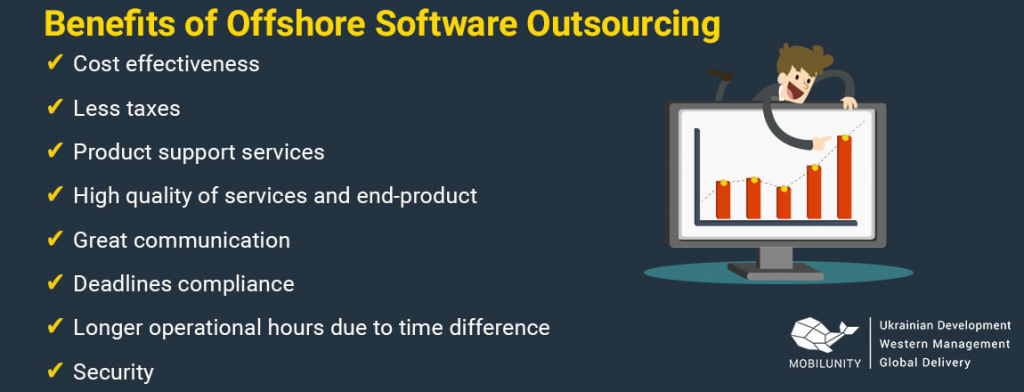The model of Offshore Development Centers is designed for customers whose strategic goal is to expand the capabilities of their own development department at the expense of the resources of an external partner. The offshore team of such a dedicated center is fully integrated with the customer’s internal team, which is optimal for repetitive development processes, such as those of software vendors. This is a strategic choice in favor of outsourcing.
Outsourcing the development or upgrade of an information system is a fairly common practice around the world. But in the majority of cases, it is a matter of engaging a contractor on the basis of “fixed cost” or “actual labor costs” interaction models.
But forms of cooperation that involve organizing a dedicated development center or offshore development center often remain out of sight for IT directors. As part of creating such a center, the outsourcer selects a team of IT specialists, taking into account the needs and peculiarities of the client’s business, who focus on implementing projects only for that client. For many offshore development companies, the use of the development center model turns out to be more useful and cost-effective in practice than other outsourcing schemes, because it helps improve the efficiency of IT investments in the long run.
When Do You Need a Development Center?
It is quite easy to draw a line between the need for a dedicated development center or working with an outsourcer under another model. If a company needs to implement one-time and small projects, its IT landscape is clear, and the degree of IT industry impact on the success of the business is insignificant, then it is better to choose traditional outsourcing schemes. Another option is when the company uses several in-house developed systems, and the knowledge of their operation technologies and interaction schemes is lost. In this case, there is a critical dependence of business on reliability and quality of IT solutions: not quick enough updating of functionality becomes a brake on development. In this case, the optimal choice is to attract an external team of specialists on a long-term basis (i.e. the use of a dedicated development center). This situation is often seen in the outsourced phone support, banking, financial and insurance sectors, and telecom companies (including those that develop and provide Internet services). The creation of a dedicated center may also be of interest to industrial and manufacturing companies.

Source: https://mobilunity.com/blog/how-to-make-your-offshore-team-more-productive/
In their latest report, the experts of Gartner, Inc hold a unanimous opinion that at present “almost scattered” new offshore programming centers have started to appear in all corners of the globe, which become serious competitors to such a strong player in the past or former so-called “trendsetter” in IT outsourcing as India.
As of 2019, according to The State of European Tech, there were 192,100 qualified software engineers in Ukraine. There are more than 1,600 software engineering organizations in the country.
Ukraine is an attractive offshore outsourcing area, which is confirmed by numerous honors, such as Gartner’s top 30 offshoring and outsourcing locations, etc.
The achievement of high-quality in-house teamwork may mean an increase in the value of specialists at the expense of investing in their professional development. As a result, the maximum value of the final score in the last two columns may not be achievable in practice.
In the case of close and constant interaction between the customer and the supplier in a dedicated center model, the analysis, design, and development processes are optimized – this reduces errors and the amount of forced “rework”. When using a fixed cost model, there is a serious risk that the price of such revisions and additional work will significantly exceed the initial estimates fixed in the bids or initial contracts. A plus in favor of using a center is also the factor of overall long-term work – it guarantees the absence of risks of communication and unpredictability, which appear if a company is constantly turning to new suppliers.

Source: https://mobilunity.com/blog/offshore-software-development-services/
A number of metrics are used to assess the quality and efficiency of a dedicated center. These include, for example, evaluations of work requests (how much time, labor, and cost are optimal and coincide with customer expectations), quality of released solutions, quality of developers’ activities (productivity, accuracy, etc.), staff turnover, resource utilization, and qualification, cost allocation
Offshore software engineering is defined as establishing a new IT engineering location in foreign lands and recruiting engineers for that offshore engineering location. The employees of this company have permanent jobs as well as those of native staff, with the main distinction that these staffs are based in different jurisdictions.
Outsourcing Models for Offshore Program Engineering
Modified Cost
With this model, the customer company and the engineering firm/development team determine locked-in pricing along with a deadline for the implementation of the project, and any future customer demand is typically reviewed in relation to value and timing. Such an attitude functions better if the two parties clearly understand the needs of a particular product and the likelihood of deviating from the demands is minimal.
Assigned Staff and Assets
This pattern assumes that the outsourcing company deploys a qualified development staff to the customer’s organization, and this staff is considered to be the customer’s workforce, operating remotely. This model is appropriate for extended-term contracts in which the customer plans to flexibly hire IT specialists; usually for building scalable code or providing post-development support for the project.
The Timing and Quality
Under this kind of outsourcing approach, the customer is paid on the basis of utilization of inputs, such as labor hours and supplies consumed. This model is used if the customer cannot precisely identify the requirements of the application, or if a test version is created ahead of a full-fledged application.

Source: https://mobilunity.com/blog/offshore-development-model/
You need to choose the proper offshore development paradigm – development hubs, specialized offshore development teams, or design agreements – according to the demands of your specific project.
Offshore Engineering Facilities: Advantages for Startups
- Availability of a worldwide workforce reserve;
- Lower operating costs;
- Divided liability concerning risk management;
- Longer periods to concentrate on the basic line of work features;
- Scalable quickly.
It is difficult to employ your own specialists because it takes time, energy, and considerable amounts of money; it leads to overwork, lower production standards, and loss of customers to rivals.
The right choice of a vendor, a well-built system of management and communication between the center and the company’s offshore development services, the use of mechanisms for controlling the work of the project team and assessing its quality will result in the minimization of possible risks of using the center and obtaining the expected effect. The customer will be able to take full advantage of the vendor’s industry and technological expertise, gained during the implementation of projects for customers with a similar scope of activity, or when solving similar tasks. The project team, starting from the manager to the ordinary programmers, focusing only on one customer, will be able to thoroughly understand the specifics of their business, correctly prioritize the requests from business users, and quickly offer solutions. As a result, tasks associated with the design and development of information systems are performed with a high level of quality and as efficiently as possible.

